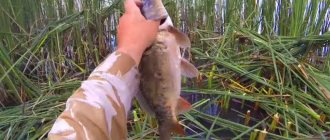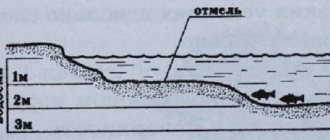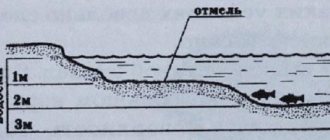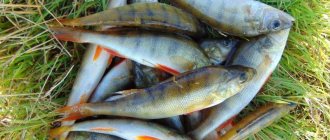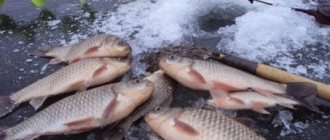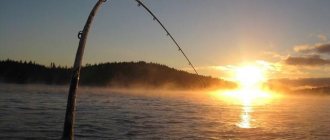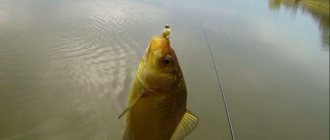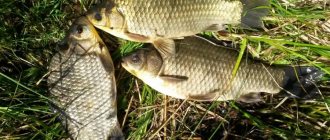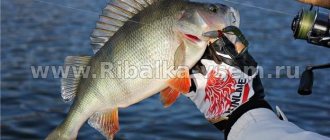Catching crucian carp in the spring is not an easy task, but to solve it it is important to know everything about the fish, its behavior and all the nuances of catching it. In addition, you must definitely find out what gear is best to choose for fishing and what bait to use for this. If you treat this responsibly, then you can count on a catch.
We'll tell you how to catch crucian carp in May using a float rod, what to do to get it to bite, and show you a video on fishing.
How crucian carp behave in spring
The peak of the spring bite for crucian carp occurs in the pre-spawning period, when the water warms up to 15°C.
Precisely when the crucian carp is hungry and not so spoiled in choosing bait. He loses caution and begins to actively eat, restoring strength after hibernation. Crucian carp leaves deep places and moves to shallower and open areas of the reservoir, where it swims out to feed and soak in the warmed water. When moving, crucian carp actively digs in the silt and therefore its presence is not difficult to notice by swaying vegetation and cloudy water, as well as emerging bubbles. Thus, it intensively searches for food in coastal areas with a silted bottom and the remains of last year’s vegetation. In May, crucian carp most often choose places overgrown with reeds and other aquatic vegetation, exits from narrow bays or areas near snags and branches. Crucian carp feeds mainly in the morning and evening, and at noon this fish prefers sunbathing. When the sun sets, fish activity stops completely, so in the spring night fishing in cold water does not bring good luck.
Crucian carp spawning
The first sign of the beginning of spawning is large schools of fish, keen on mating games in the coastal strip of the reservoir. The onset of the spawning period does not have an exact date and therefore the start date of spawning varies and largely depends on the following factors:
- Water temperature . To start spawning of crucian carp, a certain water temperature is required, which should be at least 12 degrees. Only in the presence of favorable conditions can crucian carp go to spawn.
- Weather. An important factor influencing the spawning period is the atmospheric temperature. Warm and sunny weather promotes rapid spawning, which can pass in a couple of weeks, and in some cases even faster. Lower temperatures slow down the process, and spawning can last for a month.
- Location of the reservoir. Spawning of crucian carp in central Russia begins in mid-May. In the southern regions of the country, spawning occurs 7-10 days earlier, and in the northern regions, crucian carp spawn at the beginning, and sometimes in mid-June.
- Reservoir size. The duration of spawning of crucian carp is influenced by the size of the lake, stock, pond or river. The larger the body of water, the longer the reproduction process. Consequently, the period of spawning in small stagnant bodies of water occurs earlier and lasts much shorter.
Mating games for crucian carp begin much later than for other fish living in freshwater environments. For spawning, crucian carp choose secluded places at moderate depths. For some time the fish splashes, actively and noisily rubs, then in numerous groups it hides in the thick of the algae and sweeps up the reproductive products there. These phenomena are considered the main signal for fishermen, indicating the beginning of spawning and the complete cessation of biting.
Lifestyle of crucian carp
Crucian carp lives in various types of reservoirs - in lakes and reservoirs, in large and small rivers, in swamps and peat bogs, ponds of various depths, in artificially created reservoirs, etc. And in one situation or another, crucian carp behaves completely differently. For example, if crucian carp is found in heated reservoirs, then it bites there throughout the year.
In cases where there is no large layer of silt at the bottom of a river or lake, crucian carp does not winter there, but wanders from one place to another in search of food. Sometimes he can even begin to hunt his own kind, eating crucian carp fry.
The influence of water temperature on the beginning of the spring bite
In most other reservoirs, crucian carp sleeps in winter and wakes up only with the onset of spring warmth.
The main condition for crucian carp to bite in the spring is that the water is warm enough for it. There is a statement by ichthyologists that fish leave hibernation only after the water temperature in the reservoir remains above 10 degrees Celsius for at least one week. First of all, small reservoirs and rivers with weak currents, as well as coastal zones, manage to warm up to such a temperature. Therefore, in such places, earlier than in others, the time comes when crucian carp begins to be caught in the spring. Sometimes this period occurs at the end of March - the first days of April. By the middle of the month, crucian carp begins to bite in shallow reservoirs with a dark muddy bottom.
In addition, spring is a very unpredictable time of year and sometimes it can be difficult to determine the onset of the period when to start catching crucian carp in the spring. And the influence of weather conditions on successful fishing cannot be underestimated.
Air temperature
As a rule, crucian carp become active if the air temperature remains above 15 degrees for 10 days. Just then the right time comes to catch crucian carp in the spring. But, when warm days are replaced by a significant cold snap, the crucian bite may stop until the next warming.
The role of wind in the spring bite
As experienced fishermen have noticed, a good bite of crucian carp is helped by the wind blowing from the south and west. While the wind from the north and east, on the contrary, negatively affects its activity. Moreover, the higher the wind speed, the greater the impact it has on the bite of crucian carp.
Is the weather clear or gloomy?
In spring, unlike other periods of the year, cloudy weather, and especially rain and thunderstorms, which abruptly replace clear warm weather, negatively affect the bite of crucian carp. This is explained by changes in atmospheric pressure, which this fish really does not like. It stops pecking until weather conditions stabilize. As soon as the sun appears in the sky, warming up the coastal zones, the ideal moment comes to catch crucian carp in the spring.
Times of Day
To summarize, I would like to note that when choosing the time to start catching crucian carp in the spring, you need to take into account the characteristics of the area in which you are, the characteristics of the reservoirs where crucian carp are found, the habits of this fish, as well as weather conditions. Knowing all these subtleties and taking into account most of the factors influencing crucian carp fishing, you can provide yourself with excellent, exciting fishing and return home with a decent catch.
We should not forget that crucian carp gravitate towards reed and reed thickets, in which they feel safe. If you have a shallow bay in mind, with individual reed islands scattered throughout its waters, the probability of success increases many times: it is next to them that you need to look for fish in the first place.
Few people know that early spring is the best time to catch crucian carp. Right now, in April, you can get a wonderful bite from this fish, and trophies weighing a kilo or more are not at all uncommon. Statistics say that the largest crucian carp are caught in early spring.
Photo: Alexey Murashko.
Crucian carp begin to show activity a week after the ice cover is destroyed.
It is for this reason that many of us patiently wait for real warmth, and as soon as the first signs of recovery begin, we hastily take time off from work.
To be fair, it should be noted that you can’t successfully catch crucian carp everywhere.
The first thing a fisherman should pay attention to are shallow, well-heated ponds, no deeper than 1.5-2 meters, as well as shallow bays of large reservoirs, isolated from the wind on all sides.
Here the water warms up much faster, and this is not a joke - an increase in the average temperature by literally 2-3 degrees leads to the activation of microorganisms, which the fish feed on.
And the crucian carp itself is a heat-loving fish and will not fail to warm itself up after a cold winter.
In addition, you should compare the temperature of the air and water with the direction of the wind, since the best days for crucian carp fishing are warm, fine days, during which the surface layers of the water warm up quite quickly.
It is they who are moved by the wind throughout the entire water area of a reservoir or bay in the first place, and therefore very often a situation arises when on the leeward shore the water temperature can be several degrees higher than on the windward shore.
This is where you should look for fish, and also remember that heat-loving crucian carp will react to changes in wind direction, sticking to warm water, and in the event of a sudden cold snap, it can completely reduce activity to almost zero.
We should not forget that crucian carp gravitate towards reed and reed thickets, in which they feel safe. If you have a shallow bay in mind, with individual reed islands scattered throughout its waters, the probability of success increases many times: it is next to them that you need to look for fish in the first place.
Abundant coastal thickets with pronounced windows and “paths” leading to open water are also good. Here, fly tackle is most often used, and fishing for large crucian carp is pure adrenaline!
The best fishing time for this kind of fishing is from 13:00 in the afternoon until evening twilight. This is explained simply - the first half of a spring day is still cool, and the cooled water does not promote fish activity. And only when the water warms up does the fish begin to move in search of food. Don't yawn here!
What gear to use to catch crucian carp depends on what conditions await the fisherman on the pond. So, if the priority is fishing in the coastal zone, in windows among reeds and in vegetation gaps, use classic fly tackle or a fishing rod assembled on the basis of a lapdog (if you expect to catch trophies over a kilo).
[THERE IS AN ANSWER] How to cut crucian carp for smelt fishing
The float is a classic fly float, the main line is 0.18, the leash is 0.12 mm. The float is loaded in a spaced manner, so that its position at a specific point is fixed using a pad.
Photo: Alexey Murashko.
If circumstances require long casting, you should resort to using feeder gear. It is preferable because with its help it is much easier not only to hold the point, but also to serve the bait strictly on the “table”.
The list of equipment used is not limited to classic installations - inline and paternoster; you can also add the feeder method here. The latter is good when the fish prefers to feed on a compact spot of bait and does not favor rigs with long leads.
It should be remembered that during the day, the appetites of fish can change significantly, and therefore it makes sense for the angler to keep both equipment options on hand and quickly switch between them.
You shouldn’t be tricky with bait and bait and try to reinvent the wheel. The best option would be a finely dispersed dark bait with a neutral odor, widely used when fishing in the cold season.
In some reservoirs, crucian carp responds well to the addition of fishmeal; here crucian and carp mixtures based on it can help out.
As an additive that attracts and retains fish in the cold season, of course, “meat” is used: bloodworms, maggots, chopped worms, caster. These additives perfectly hold suitable fish for a long time, ensuring an active bite.
There are reservoirs in which crucian carp have an extremely negative attitude towards plant bait, but react well to “meat”. In such a situation, you should resort to using clean soil from molehills, brought to the required consistency with water.
Animal components are added to it immediately before feeding, without affecting the mechanics and allowing them to be delivered to the fishing point even at a long distance.
The list of attachments is also not very diverse. Bloodworms, maggots and worms are used; in combination with each other, these three attachments allow you to get a bite in almost any situation. The most commonly used vegetable baits are semolina and steamed pearl barley.
In some situations, it is useful to use flavorings for the bait. When the fish is capricious, the right scent can activate it and provoke a bite.
The best smells for cold water are the smells of caramel, vanilla, garlic, fishmeal, as well as other strong meat and fish aromas.
As soon as everything returns to normal, the hunt for this individual is resumed. In the southern regions, the water level recovers faster, so fishing for crucian carp here begins earlier.
Bait selection
The bite for crucian carp in May is quite stable, except for the spawning period. At the beginning of the bite, you need to rely more on small animal baits (maggots, bloodworms, worms). With warming, crucian carp become more active, so it would be more advisable to move on to larger baits, using larger hooks with an increased portion of bait.
Classic baits for crucian carp in spring
- Maggot fishing. In order for the fishing to be successful, it will be more correct to hook the larva across and closer to the head, then its natural movements will be able to attract fish.
- Bloodworm fishing. For this type of bait, hooks No. 2.5 - 3.5 are best suited. You need to bait the worm by the head so that it hangs on the hook and remains alive. Then he will be able to interest the voracious crucian carp with his movements.
In addition, crucian carp does not refuse various types of insects. Particularly suitable for bait are: ordinary flies, grasshoppers, bark beetle larva, dragonfly larva, leeches, caddis flies, beetles and others.
In addition to animal baits for catching crucian carp in May, you can use vegetable baits:
- Steamed grains of cereals, corn, peas;
- Canned peas;
- Bread crumbs with the addition of halva, flour and honey;
- Chattered peas;
- Semolina and other porridge.
Crucian carp can be appeased by using combined baits, which are prepared from bread, potatoes, millet porridge, as well as flavored additives and oil.
Characteristic features of spring crucian carp and its diet
Now let's talk about how crucian carp behaves and bites in various spring months: March, April, May.
Fishing for crucian carp in March
After winter, this fish seeks warm water in the shallows, under the crust of last year’s sun-warmed reeds. At this time, it reacts sluggishly to bait. The exception is established thaws.
He prefers bait of animal origin - a dung worm or a sandwich of several bloodworms and maggots. It starts pecking after ten o'clock in the morning, when the sun is hot.
Useful and interesting:
Fishing for crucian carp in April-May
The pre-spawning feast of crucian carp begins as soon as the water temperature approaches 10 degrees. This fishing eldorado lasts 2-3 weeks.
The most versatile and catchy tackle is the float rod in its various modifications. During this period, the fish feeds intensively. Prefers small animal baits.
You shouldn’t feed too much, just periodically use small portions of bait to keep the fish in the fishing area. Crucian carp bite almost all daylight hours, but the largest specimens are caught in the early morning.
Spawning of crucian carp begins in water heated to 15 degrees. Depending on weather conditions, this is the end of May - beginning of June. The fish practically stops feeding and reacting to any bait. You shouldn’t even try to catch crucian carp at this time.
Although crucian carp is considered a simple-minded fish, the fact that it is capricious is an indisputable fact. Experienced fishermen, preparing for crucian carp fishing, take with them various baits of both animal and plant origin.
During the day, the preferences of crucian carp change unpredictably. Just as I confidently pecked at the worm, suddenly there was a lull. I changed the nozzle to pearl barley porridge and there was a revival again.
It is necessary to catch crucian carp hastily, although in cold water it still does not resist at full strength. But it costs him nothing to break the jig or straighten the hook with his weight, making another somersault.
When catching crucian carp, active play with a jig is not required. Rather, on the contrary, it will be caught either by “standing” or by small, smooth swaying of the bait at the very bottom. Usually they fish with several fishing rods at once, every now and then lifting and shaking the nozzle by the nod. Some people equip their fishing rod with a float, while others prefer a nod – this is not for everybody.
At this time, bloodworms, maggots, jigs, and worms are used as bait. The preferences of crucian carp depend on the specific body of water. A combination of these attachments often helps out a sandwich. They are most often fed with mormysh; vegetable baits are not particularly held in high esteem by fish at this time. But to attract the attention of the fish and create a cloudy column, you can add “dusty” complementary foods.
Crucian carp are quite cautious, even when hungry. He tries the bait several times, and if nothing bothers him, only then will a confident bite follow. Therefore, be patient, you should not hook from the first movement of the nod, let the fish swallow the bait. This is the skill and endurance in such fishing.
They use different jigs; it is better to use more powerful ones with strong hooks. In some reservoirs, crucian carp continue to feed at night. For night fishing, it is better to use light-accumulating jigs coated with phosphorus.
Consider the strength of this fish. Sometimes worthy specimens of large crucian carp fly in and put up a real fight with thin tackle. Sometimes carp and carp are caught as bycatch. It's a shame if the tackle can't withstand the heat of the fight.
It is necessary to catch crucian carp hastily, although in cold water it still does not resist at full strength. But it costs him nothing to break the jig or straighten the hook with his weight, making another somersault.
It is better to choose search tactics, since catching crucian carp in early spring at one point may not bring any results at all.
If the weather is not capricious, the sun is shining, there is no wind, and the thermometer shows more than 10 degrees Celsius, the crucian carp can bite throughout the day. And yet its activity is not always the same.
[THERE IS AN ANSWER] How to catch a large crucian carp among small ones
Match fishing rod - allows you to cast bait a decent distance from the shore, so you can fish with it all day long. The main thing is to assemble it correctly. There is one rule in match fishing: the longer the rod, the further the cast. This must be taken into account when planning your fishing trip. It is advisable to equip it with a comfortable reel with a soft stroke and a reliable clutch. The fishing line used is dark, quickly sinking, with low memory.
Crucian carp lives in various types of reservoirs - in lakes and reservoirs, in large and small rivers, in swamps and peat bogs, ponds of various depths, in artificially created reservoirs, etc. And in one situation or another, crucian carp behaves completely differently. For example, if crucian carp is found in heated reservoirs, then it bites there throughout the year.
Bait for fishing for crucian carp in May
The basis of crucian carp fishing is bait. Each fisherman, when going fishing, must take care in advance of feeding the crucian carp fishing area, which, if possible, should be done for several days in a row. This technique is effective and works well in bodies of water where there is practically no current.
The main task when feeding is to guess the amount of bait.
It should be in moderation to prevent overfeeding of the fish. When using float gear, small quantities of complementary food must be supplied to the fishing sites, but if donkey is used, complementary feeding from feeders will be sufficient. To feed crucian carp in May, both home-made mixtures and industrially produced formulations are used.
A wide range of mixtures allows you to choose bait that is ideal for certain conditions. If you plan to catch crucian carp in cold water, then it is better to take a composition with the smell of anise. If you have to fish on the river with a feeder, then the “Feeder - crucian carp” mixture will be an ideal option. The main condition for selection is that the mixture should have a pleasant and non-irritating odor. In spring, you should not use bait with sharp and cloying aromas. Crucian carp in May is unpredictable and overly demanding, and in addition, in each individual reservoir its taste preferences may differ, so the composition for feeding must be selected experimentally. For crucian carp food, you should not use a coarse mixture. The result of the catch is positively influenced by well-ground corn and barley , wheat , rye crackers , oatmeal , wheat bran and fresh cake .
For a good bite, it is better to use the following baits:
- Well-steamed millet with pieces of worms added.
- An industrial mixture mixed with soil from a reservoir at a ratio of 50/50 and with the addition of live ingredients (maggots, small bloodworms and worms).
- Composition of Hercules mixture and boiled potatoes, sometimes slightly roasted sunflower seeds are added to the fertilizer for flavor.
For a good aroma, the bait is often supplemented with sunflower oil, cinnamon, a few drops of natural dill juice or vanillin.
Equipment of a float rod for crucian carp
To catch crucian carp, you can use a wide variety of gear, from a float rod to a feeder. However, the classic float tackle remains a win-win option. It is unpretentious and easy to assemble.
To do this, you need a fishing rod , the length of which depends on the fishing distance, but since crucian carp is most often caught among algae, it should not be too long, about 5-6 meters.
The rod is equipped with a fishing line with an excellent breaking load of up to approximately 3 kg and a diameter of 0.14 to 0.16 mm . A fishing line with such parameters allows you to successfully catch crucian carp, even with strong resistance.
a float of small size, elongated shape and weighing no more than 3 g, since when casting with a float of such weight, unnecessary noise can be avoided.
Hooks are selected according to the type of bait, usually No. 5-6 are used.
For sinker purposes, it is best to use lead pellets.
Is it worth fishing on a feeder?
Despite the fact that in spring float tackle is more relevant, this does not exclude the possibility of using feeder rods. As a rule, both methods have their advantages and disadvantages, and therefore the choice of gear depends on the reservoir and the conditions of the area where fishing will be carried out.
Leash length 1-1.2 meters
For example: for a small reservoir with abundant aquatic vegetation, feeder gear is unlikely to be suitable, since crucian carp, including large specimens, stay under the shore in the reeds, which means there is absolutely no need to cast far. But the casting range is the main advantage of the feeder. With the necessary gear and a thin cord, the feeder can be cast a hundred meters, but this is only applicable in large reservoirs and large reservoirs, where the fish stay far from the shore. As a rule, in spring crucian carp stays closer to the shore, so in spring it is better to use float gear for catching crucian carp and only in windy weather and in strong currents can you prefer a feeder.
Fishing for crucian carp in spring: 2 periods
The reservoir is still covered with ice. First thaw. Reservoirs become free of ice with the current no earlier than March. For reservoirs without current - depending on the air temperature, depth and size of the reservoir.
During this period, in most reservoirs, crucian carp are still in hibernation.
As an exception, we can name heated reservoirs and reservoirs in which the layer of silt does not exceed 5 cm. In such reservoirs, crucian carp does not sleep in winter, but continues to actively move around the reservoir.
The activity of crucian carp is close to zero. The exception is large specimens of this fish, which lead a predatory lifestyle.
Many fishermen note that large crucian carp are caught not only on the usual winter float or jig, but also on live bait tackle
The reservoir is gradually freed from the ice cover and overflows due to melt water entering the reservoir. For reservoirs with a current, this period begins at the end of March, for reservoirs of calm water - most often at the beginning of April.
During this period, crucian carp emerges from hibernation but does not yet show much activity. The fish gather in schools, rise to the surface of the reservoir and slowly move in search of warm water.
During this period, crucian carp can be found at the confluence of shallow rivers and streams. In ponds and reservoirs it often appears in shallow water.
Fishing technique and nuances
Fishing for crucian carp in May differs from catching it in the summer. Shy crucian carp not only sees the figure of the fisherman, but also feels the vibrations of the ground under his feet, so it is recommended to catch him while sitting. Having chosen a place, you should carry out several basic fishing techniques:
- Feeding . If feeding is carried out directly on the day of fishing, then it is more correct to do this 30 minutes before the start. For this purpose, bait balls are used, formed from coastal soil and bait, which are thrown to the planned location of the fish. This must be done quietly and carefully approaching the water so as not to spook the fish. Considering that crucian carp prefers to stay in places where the bottom is not very muddy and quite strong, the bait should be fed closer to the bottom.
- Casting Throwing the equipment should be done with smooth pendulum movements. When casting equipment into the intended fishing spot, you should make as little noise as possible.
- Sweeping. If the float begins to make repeating movements up and down, then sharply goes to the side, and after emerging, lies flat on the water, then in this case you should perform a sharp and short hook. You need to carefully prepare for hooking, because if you hurry, the fish will not have time to capture the “prey.” If you delay hooking, the crucian carp will have time to gnaw the hook.
- Fishing. After hooking, the crucian carp becomes very active, but in this case the rush will be unnecessary. It is better to starve a resisting fish and make it tired, and only then can you start fishing. When the crucian carp appears, you need to carefully bring it into the landing net. The most important thing is to prevent the fish from getting the line caught in grass, snags or flooded bushes. When catching small crucian carp, you should carefully lift it from the bottom and “lay” it on its side and pull it to the shore, preventing it from sinking.
Experience has shown that fishing for crucian carp in May has its own characteristics. It differs from summer fishing not only in bait, but also in the choice of location, tactics and feeding of fish. If you take fishing seriously, you can get not only pleasure, but also a good result.


